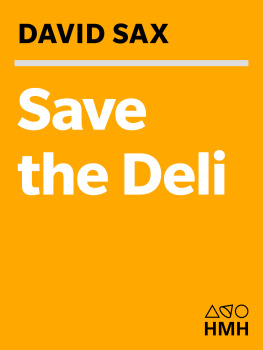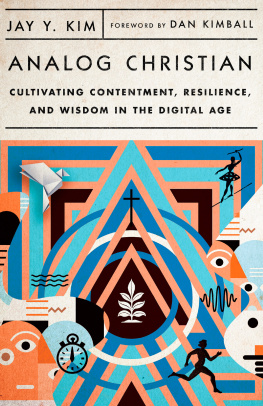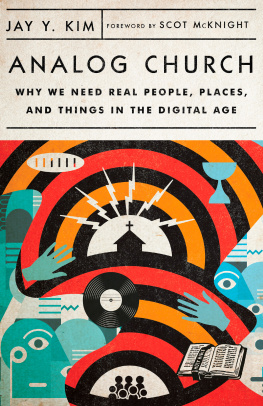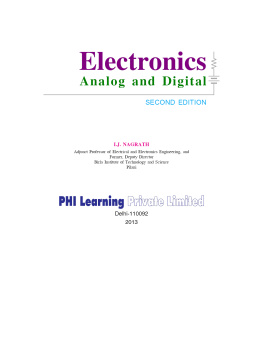

Copyright 2016 by David Sax.
Published in the United States by PublicAffairs, an imprint of Perseus Books,
LLC, a subsidiary of Hachette Book Group, Inc.
All rights reserved.
Printed in the United States of America.
No part of this book may be reproduced in any manner whatsoever without written permission except in the case of brief quotations embodied in critical articles and reviews. For information, address PublicAffairs, 250 West 57th Street, 15th Floor, New York, NY 10107.
PublicAffairs books are available at special discounts for bulk purchases in the U.S. by corporations, institutions, and other organizations. For more information, please contact the Special Markets Department at the Perseus Books Group, 2300 Chestnut Street, Suite 200, Philadelphia, PA 19103, call (800) 810-4145, ext. 5000, or e-mail .
Book Design by Jack Lenzo
Library of Congress Cataloging-in-Publication Data
Names: Sax, David, author.
Title: The revenge of analog: real things and why they matter / David Sax.
Description: First Edition. | New York: PublicAffairs, 2016. | Includes bibliographical references and index.
Identifiers: LCCN 2016012413 (print) | LCCN 2016027805 (ebook) | ISBN 9781610395724 (ebook)
Subjects: LCSH: EntrepreneurshipHistory. | Electronic commerceHistory. | Marketing. | BISAC: BUSINESS & ECONOMICS / Industries / Retailing. | SOCIAL SCIENCE / Popular Culture. | TECHNOLOGY & ENGINEERING / Manufacturing.
Classification: LCC HB615 .S3137 2016 (print) | LCC HB615 (ebook) | DDC 306.3dc23
LC record available at https://lccn.loc.gov/2016012413
First Edition
10 9 8 7 6 5 4 3 2 1
Table of Contents
Guide
Contents
A new medium is never an addition to an old one, nor does it leave the old one in peace. It never ceases to oppress the older media until it finds new shapes and positions for them.
Marshall McLuhan, 1964
JACKIE TREEHORN: New technology permits us to do very exciting things in interactive and erotic software. The wave of the future Dude, one hundred percent electronic.
THE DUDE: Hmm... well, I still jerk off manually.
The Big Lebowski, 1998
I n June 2012, a new store called June Records opened its doors in Torontos Little Italy neighborhood, a block and a half from a house Id just purchased with my wife. June Records looked nothing like the dusty, cluttered record stores Id grown up visiting. It was a modern, well-organized, well-lit retail space, almost a boutique. Walking through the neighborhood shortly after I bought the house, I was stopped on the sidewalk outside June Records by the beautiful sounds coming from the turntable playing in the window. The album was Aretha Franklins Live at the Fillmore West, and the combination of the Queen of Soul and a sunny summer day in my new neighborhood was impossible to resist. I walked in, asked how much the record cost, and walked away with Aretha under my arm, practically dancing down the sidewalk with elation.
Like most music fans, Id spent the preceding decade gradually divorcing my music collection from physical reality: loading CDs into iTunes, iTunes onto my iPhone, and eventually the whole deal into the cloud. I still owned a turntable, an old Technics given to me by my friend David Levy, but it had been sitting in a box at my parents house for more than two years, utterly neglected. The $20 I had spent on that record at June was more money than I had spent on music of any kind over the same time.
That fall, we moved into our house, I set up my turntable, and finally played Aretha in all her sweet glory. Within a few bars of Respect, it dawned on me that this was the first recorded music I had actively listened to in ages. It had been months since I had opened iTunes on my computer, and I had no songs anymore on my phone. All those albums were hidden in my hard drive, nestled between old e-mails and various other files, beyond my sight. Most days I just listened to public radio in the kitchen or the car. When my brother bought me a subscription to the streaming service Rdio, I frequently found myself opening up the app, only to become paralyzed with indecision. My options were infinite, literally every single album and song ever recorded. What did I want to listen to? It was as though the ease and convenience of digital music had sucked the very fun out of listening to it. The entire world of music was just a click away, but I couldnt even be bothered to do that. What if there was an even better song, just a few taps away? Something was missing. The way to bring it back, I now realized, was vinyl.
I found myself purchasing records whenever I could. I began by digging through the discount bins at June Records for old jazz and soul albums, but was very soon buying freshly pressed, newly released records by bands and artists I learned about by actually talking to Junes staff. Often, if something was playing on the turntable there, Id pick it up: the harmonic guitar rock debut from local band Always, a fresh compilation from Nigerian psych-disco hermit William Onyeabor, the stripped-back instrumental hip-hop collaboration from rap legend Ghostface Killah and funk band BadBadNotGood. My new collection, which numbered maybe a dozen old records when I moved into the house, swelled so quickly, my wife declared a hard limit on the number of shelves it could occupy.
I was having too much fun to care. My modest vinyl fetish had tapped into something that was lying dormant since my first Napster download: the carnal pleasure of physically browsing and buying music. I would walk by a record store and suddenly the $10 bill in my wallet would begin burning, demanding to be spent. Half an hour later I would emerge with an album under my arm, my face swollen with pride, as though I had recorded the damn thing myself. In an age when I could have the exact same music for free, and play it on five different devices, here I was paying good money for scratchy, heavy, cumbersome discs of melted plastic that I had to play on a machine as temperamental and costly to maintain as an old car. It was totally irrational.
I wasnt alone in this madness. Every few months, Id stumble on a new record shop that had just opened, or an older one that was suddenly expanding to a second or third location. Each time one did, it seemed like a minor miracle. Record shops had been doomed to extinction in the collective imagination ten years before, deployed as a metaphor for dying retail businesses that failed to adapt to the digital era (If bookstores dont figure out the web, they could go the way of the record store). Nobody opened new record stores. No one.
Then, overnight it seemed, these retail dinosaurs were not only back from the brink but walking among us, and multiplying in every corner of the world. News stories about the death of the record store were replaced by stories about the anomaly of record stores defying the odds, new record stores like June opening, and finally confident declarations that record stores were not only back, but were actually thriving. The number of new vinyl records pressed and sold has increased more than tenfold over the past decade, resulting in a similar boom in turntable sales, and record stores opening. June Records, for example, has grown its sales by roughly 5 percent, every single month since it opened, according to the stores co-owner Ian Cheung, doubling its revenue pretty much every year that June Records has been in business. Just last month, yet another record shop opened a few blocks away from June. Cheung told me he isnt worried about competition. The more record stores that are out there, the more relevant June seems.













